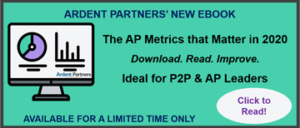Today we continue our look at solving AP’s reliance on paper by looking at the second phase of the process: invoice processing (click here to read Part 1 on Invoice Sending & Receipt). The AP department is one of the last groups within many enterprises to operate using what are largely or fully-manual processes. These manually-intensive processes are more costly and take significantly more time to complete than those that leverage process automation seen at other companies. Additionally, the lack of visibility into current processes places a strain on the finance department, the line of business, and trading partners. Recent events have shown us the challenges of AP departments operating with a reliance on paper-based, manual processes. The largest problems faced today are:
- Inability to function as a ‘remote-work from anywhere’ operation – Paper-based processes tie the AP department to a physical location preventing it from effectively operating in today’s work-at-home business environment.
- High processing costs – A highly manual and largely paper-based invoice processing results in an invoice processing cost that are between 50% – 90% higher than automated AP departments. An un-automated process, simply put, has too many people working on the tactical aspects of processing invoices and, the process overall, is too slow, because each step of the process is manual.
- Lengthy processing times – The highly manual nature of invoice approval process means that it can take weeks to find and route an invoice through an approval process that could be “touchless” in an automated environment. This results in staff members and others outside of AP spending valuable time on non-value-added tasks.
- Lost early payment discounts – The overwhelming paper flow and generally manual nature of AP processes makes it difficult and all but impossible to realize any early-pay discounts. The potential return on these discounts can be significant but in a manual process potential discounts are lost due to an inability to approve invoices quickly.
- Late payments and late payment fees – In addition to costing an organization money, late payments to suppliers can serve to erode the relationships you have with your trading partners.
- Exceptions, errors, and other discrepancies – Invoice exceptions are the largest resource burden within any AP department. High invoice processing costs are made even higher by the amount of time AP staff spends on resolving invoice and payment errors that are both harder to detect and take longer to resolve in a manual environment. Additionally, in a manual environment, it is very difficult to perform a root cause analysis and begin to try and reduce exception rates and the same exceptions happening over and over each month.
- Lack of visibility – Paper-based processes make it almost impossible for the AP department to have a full view into its processes and the status of any invoice. This lack of visibility creates an environment where AP staff is spending more than one-third of its time responding to internal and vendor inquiries. Other stakeholders are also significantly impacted by this lack of visibility including:
- Finance which struggles to close out each month due to a lack of visibility into invoice liabilities and disbursements
- Treasury which is unable to enact a proactive cash management strategy related to vendor payments due to a lack of visibility into invoices and payment terms
- Procurement which is unable to track supplier invoice performance and any extra costs/burdens associated with the relationship
- Line of business which receives invoice and payment inquiries from its key suppliers and is unable to provide timely and accurate answers
Automating the manual processing of invoices will result in a plethora of benefits for both AP departments and the wider enterprise. First and foremost, automation of invoice processing will enable AP employees to work from anywhere and not be tied to a physical location or office. It also means that invoice approvers can also be located anywhere since the approval process all happens digitally. For AP staff members, automation will change the way they carry out the activities and duties tied to invoice processing.
With an automated ePayables solution (Esker, Corcentric, Tradeshift, MetaViewer, Transcepta, MineralTree, Yooz, Bottomline Technologies, Inspyrus) the AP staff will find that the number of invoices they are required to ‘touch’ will be greatly reduced as will the amount of time spent on each invoice since the system will make it much easier to easier to automatically validate, match and route invoices for approval. Invoices can be processed for approval based upon certain business rules and thresholds that are configured in the solution. The end result is that more invoices will be processed and approved automatically (also known as “straight-through” processing) by the system without direct staff involvement. This will enable the AP team to focus on more of the value-added activities within AP like managing exceptions and responding to inquiries. The net result is that our invoice processing times will be greatly reduced and overall accuracy greatly increased.
Take the State of ePayables Market Research Survey Today!
An automated ePayables solution solves the most pressing needs today of many manual, paper-based AP departments, that being able to ‘work from anywhere’ as well as the plethora of added short- and long-term benefits that invoice automation brings including providing a greater level of visibility into AP-related activities which can help improve the overall cash flow and working capital management strategies for an organization which are more critical than possibly ever before.
RELATED RESEARCH:
Tagged in: Accounts Payable, AP Automation, ePayables, Innovation, Solution Providers, Technology










